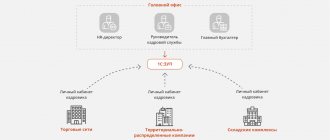Employee engagement theory has gained increasing acceptance over the past few years. This theory examines how a company can achieve its strategic goals by creating an environment for people development in which every employee, manager and executive will do their best for the benefit of the company.
This theory is based on simple common sense and is therefore difficult to even describe. This difficulty stems from a long history of ineffective methods and incorrect theories in the field of organizational management. Employee engagement theories and best practices are finally bringing us back to reality and common sense.
In short, this theory states that the leader of an organization must create an atmosphere in which all employees work at their best: so that they are fully “on”, so that not only their bodies, but also their minds are present in the workplace. In other words, to ensure that employees are fully committed and involved in their work, just as an entrepreneur cares about his own business, or as each of us cares about our own home. This is called involvement: it is personal interest in an activity that occupies our full attention, and in which we are willing to put forth our best effort.
Really, it's just common sense. What employer wouldn't want their employees to work this way? Why is theory needed? Theory is needed as a tool to eliminate ineffective management practices that have been ingrained over hundreds (if not thousands) of years of mismanagement. In reality, very few employees are fully engaged at work, and very few leaders know how to change this. According to research conducted in the UK, only 12% of employees (on average, in any company) are actively engaged. In Europe this percentage is even lower. Even so, these numbers are based on employees' self-reported levels of engagement, suggesting that these self-assessments are skewed by the tendency we all have to exaggerate our own strengths. According to the same study, 65% of employees believe they are “moderately engaged.” This means that work is important to them, but they do not invest emotion into it. The results of other studies confirm this: more than half of employees believe that they do not work with full dedication, and only 40% say that they are fully dedicated to their work. According to consulting firm BlessingWhite, only 31% of employees are actively engaged in their work. Imagine how a football team would play if only 12% of the players were truly involved in the game, and the rest on the field were thinking about vacation, upcoming dates, or what they read on the Internet that morning. The point is that a successful sports team is always run according to the principles of inclusion, even if they are called something else.
Any theory or concept serves two functions: first, it is a symbol that helps you learn about a new way of thinking about certain problems. (Unconsciously, we have always known that engaged employees perform better than passive ones. The new theory helps us realize what we have always felt intuitively.) Secondly, it provides guidance on how to achieve the ideal state - from the point of view of this theory. In terms of employee engagement, I think the first function is already very valuable - as soon as we start thinking about something, we immediately look for ways to achieve it. But employee engagement theory also helps chart a course for leadership to fully engage all employees at work, or, as they now say, create a “road map” for creating a culture of inclusion. In my opinion, the ultimate destination of such a roadmap is a corporate culture of inclusion - a system that automatically supports engagement at all levels of the organization. In this book we will talk about how to create such a culture.
I'm not a big fan of definitions, but if they are flexible enough, then they help clarify new ideas and can be a guide to action. I define employee engagement as follows:
Employee engagement is an approach to ensuring that every employee genuinely cares about their job, the company they work for and its customers, an approach that helps ensure that the employee is fully committed to his work and makes every effort in this regard. This translates into the employee being proactive and enthusiastic about the job and taking full responsibility. Employee engagement is a two-way street; it is a relationship between employer and employee based on trust and respect. To achieve engagement, company leaders and managers must create clear and broad communications, make it clear to employees what is expected of them, empower them based on their level of competency, and create a work environment and corporate culture that promotes engagement.
More briefly, we can say:
Employee engagement is a theory about how to achieve a company's strategic goals by creating an environment for staff development where every employee, manager and executive does their best for the benefit of the company.
There are several management theories that are often confused with employee engagement theory—at first glance, they are indeed similar. Among them: the theory that employers should ensure that employees like their jobs, or the theory of job satisfaction (it was especially popular in the 70s); employee loyalty theory (it came into fashion in the 80s); and employee empowerment theory (emerging in the 1990s). All of these theories also relate to the idea of motivation. I wouldn't say that these theories are wrong. Rather, they are flawed and incomplete when used in isolation as the basis for employee engagement theory. However, by combining them into a single whole and supplementing them with some other important and new ideas about management, it is possible to create, overall, a fairly reliable theory of engagement. We will briefly discuss these theories below.
ENGAGEMENT AND JOB SATISFACTION
In discussions with those unfamiliar with the concept of employee engagement, they often find themselves associating the concept with a management theory popular in progressive companies, especially in the 80s and 90s, that employers should ensure their employees are satisfied with their jobs. The basic idea is that the more satisfied a person is with his job, the better he performs. Engagement experts will agree with me that this is not true. The problem is that this theory only focuses on one-way traffic: the employer provides employee satisfaction, but no one says what to expect from employees in return. This problem was exacerbated by the tradition of conducting job satisfaction surveys. It was believed that the higher the level of employee satisfaction reflected in the survey, the better the management of the company. As a result, managers sometimes even “bribed” employees—that is, they sought satisfaction with various benefits, bonuses, and a Disneyland-like work environment without asking for anything in return. Today, it is increasingly recognized that satisfaction in itself does not lead to improved performance; on the contrary, it is quite possible that the employee is satisfied with the job only because it pays decently, allows him to enjoy benefits, the company has a pleasant atmosphere, and the employee himself can do other things not related to work in which he is more involved. Contentment can turn into laziness, and in fact prevents you from challenging the status quo and creating innovation, which is what engaged employees are expected to do. Contentment does not motivate you to seek new paths, focus, and exert your best efforts—these qualities that underlie true engagement.
Job satisfaction surveys often confuse cause and effect. This is a classic philosophical problem: which came first - the chicken or the egg. Are companies with satisfied employees successful because they care about employee satisfaction? Or do employees report satisfaction because successful companies often intuitively create inclusion policies? And how do you know whether a company's success is due to a satisfaction policy or something else? Perhaps it is due to other reasons, and only profitability allows the company to share its success with its employees. (Of course, that's not bad either).
Job satisfaction is also a matter of comparison. A person may say that he is satisfied with his job for various reasons, which for the most part he is not aware of. And you should always keep in mind the universal human tendency to complain about fate.
Another problem with job satisfaction surveys is that they are typically designed to ask employees how satisfied they are with their jobs, and therefore with their management and employer. I think it is equally useful to ask managers (at different levels) about how satisfied they are with their employees. Then we would be on a two-way street.
Engagement metrics
Alexey Klochkov, content director at Happy Job, spoke about the platform’s metrics.
The Happy Job service shows the state of engagement in 10 metrics with 5 submetrics each.
Clear goals, effective meetings and a results orientation define the qualities of a leader.
Companies that communicate strategy to employees and measure performance achieve the best financial results in the industry.
Recognition occupies an important place among the drivers of motivation. Most employees would work harder if they were praised more accurately and more often.
More than 75% of employees said they wanted more feedback from managers that was designed to inspire better results rather than offend.
Understanding the processes, requirements and boundaries of one's responsibility affects the intellectual engagement of any person.
The metric evaluates the possibility of introducing changes (new technologies and processes) in the company with the help of project management.
Good relationships, mutual understanding and effective communication in a team are the most important components of engagement.
When employees are healthy, happy, and have a good life/work balance, they are friendlier with clients, colleagues, and more productive—by at least 40%.
45% of employees leave companies or are underemployed due to lack of career prospects.
Remuneration is one of the main drivers of intellectual involvement and motivation to work, but it is always not the main one.
The most accurate way to obtain information about the state of engagement is to use 100% anonymous online employee surveys.
Employees answer 50 questions, and their answers are analyzed and compiled into online reports.
10 engagement metrics and all the questions
You can find out full information about the 10 metrics and questions on engagement and loyalty offered by the platform in the booklet.
Get the methodology and questions in PDF
ENGAGEMENT AND LOYALTY
Until recently, when engagement theory was not yet widely accepted, progressive leaders and HR managers talked about employee loyalty. Experts are now debating what, if any, differences the two paradigms have. Some argue that they are just different terms for the same concept, but I think they are different theories. We can say that the theory of involvement is a higher stage of evolution of the theory of loyalty, its improved and more complete version.
It should be pointed out here that I am not alone in criticizing certain concepts, and I am not alone in thinking that different concepts are indeed based on different ideas. But I want to point out that, as I understand loyalty theory, it lacks certain key elements present in engagement theory, and yet it contains elements that can be misleading.
In my opinion, the loyalty theory is more based on coercion, on creating conditions in which the employee feels obligated to continue working in the organization, while the engagement theory seeks to create a situation where the employee remains free to choose and has an internal desire to work for the benefit of the organization . Loyalty can be called one-sided coercion, but involvement is mutual: both the employee and the employer are involved. Somewhat simplified, we can also say that in a situation of loyalty a person has a rational attitude towards the company, he weighs all the pros and cons; and in a situation of involvement, he makes a free choice, and not on the basis of “calculation,” but because he sincerely wants it. Rather, it is an emotional choice. If the company's management follows the loyalty theory, it also seeks to create an emotional connection with employees, but contrary to the engagement theory: the company's management tries to make the employee feel that he owes something to the company that has done so much for him; or “tying” an employee with a large salary, or an even more popular form of temptation - offering employees options and other benefit programs. The problem with all of these methods is that they may not be effective in terms of employee retention. But... will people who are retained in this way actually put in their best effort for the good of the company? Hardly.
Loyalty can also be understood as loyal behavior combined with intrinsic motivation for involvement.
An analysis of Meyer and Allen's three-component model of loyalty helps differentiate between these two theories. These researchers divided loyalty into three components: affective loyalty, continuance loyalty, and normative loyalty. The last two components indicate the compulsory nature of loyalty.
Continued loyalty, as is commonly believed, is based on calculating the “pros” and “cons” of further work in the organization. In this case, a person remains in the organization if he believes that his “losses” in case of leaving will be higher than the “profits” if he remains in the organization. Naturally, the factors that enter into this equation are not necessarily measured in money, but include, for example, issues of status, membership in a particular community, etc.
Normative loyalty is a perceived or actual sense of duty to an organization that encourages people to stay with it.
According to engagement theory, company management does not need to try to artificially create continued and normative loyalty, but the remaining element, emotional loyalty, has a place in the engagement paradigm. Emotional loyalty is an employee’s positive emotional attachment to the organization, the element of “desire” in organizational loyalty. At the same time, the employee, as they say, identifies himself with the goals of the organization and strives to remain in it because he wants to.
Make work fun
Work cannot be so monotonous and so routine that there is no fun. It's so discouraging to come to work, to a place where you just work.
While setting ambitious goals and following through is very important, you still need to have some balance. The trick to making work “fun” is to eliminate the fear that exists in many companies. Employees need to know they can have fun and relax a little.
Tips for Implementing Employee Engagement
Have Fun: Encourage fun at work and, most importantly, have fun yourself. Employees need to see you having fun too so they know everything is okay. It doesn't have to be something fantastic. Something as simple as a team lunch can help break up the routine and create employee engagement.
Organize team building activities: These can be informal, you should try to find ways to bring the team together outside of work. This can be difficult for people with different commitments (children, school, etc.), so it makes sense to organize several different events. Happy hours, karaoke nights, pancake breakfasts, and paintball have worked very well in some offices.
Plan an event: You can try to find a way to give employees something that everyone will enjoy, such as a company barbecue or a company breakfast/lunch when you relax with the team. This usually makes sense when you need a way to celebrate passing a milestone.
Employee Engagement Idea #4
ENGAGEMENT AND EMPOWERMENT
Engagement also differs from another management concept that has been popular in the last two decades: empowerment theory. This theory states that employees need to be given authority, particularly to make important decisions. Of course, it is very important that employees are empowered to make decisions within their tasks, and in this sense, empowerment is an important aspect of engagement. But the problem is that empowerment is meaningless, and it is not feasible without the other aspects of engagement. Empowerment can only be granted to those employees who demonstrate a sufficient level of commitment. Another important aspect: the company must employ suitable employees; It is unwise to give authority to just anyone. And most importantly, empowerment must be rooted in an inclusive corporate culture. To give adequate authority to employees of different levels of responsibility and competence, a culture of self-discipline and self-organization is necessary.
ENGAGEMENT AND MOTIVATION
Engagement goes hand in hand with motivation. But here we need to clarify the very understanding of motivation. The dictionary defines “motivation” as “the drive to action or the process of motivation,” or as “the conditions under which motivation occurs.” Most often, in the context of management theories, it is customary to talk about motivation as “the act or process of motivation.” A “carrot and stick” mentality emerges: how to get employees to behave one way or another. But in engagement theory we talk about a different sense of motivation: “the conditions under which motivation occurs.” In this case, the task of the company’s management is to create such conditions so that employees have internal motivation, or self-motivation, as I prefer to call it. Motivation - that is, the desire to make every possible effort - must arise from within, and not from external pressure (positive or negative), and not under the control of management.
Influenced by the traditional understanding of this concept, employers have been scratching their heads trying to come up with attractive new ways to extrinsically motivate employees. First of all, of course, what comes to mind is salary, salary and salary again, as well as benefits in the form of bonuses or other incentives, for example, options and so on. And also, of course, a good position and a worthy position in the hierarchy. And don't forget about punishment, in different forms. If the company's management thinks this way, then it creates a system of constant "trading": if you do this, you get this; If I don't get it, I won't do it.
In engagement theory, this idea is reversed. Here, the employer seeks to uncover the sources of internal motivation of employees, to create such working conditions and such relationships in the company (between its leaders, managers and employees) so that people are internally motivated to do the best they can. Obviously, salary and financial benefits remain important, but they are no longer the only means of motivation.
Here we move from trying to create motivation for this or that behavior using carrots and sticks to a driver that allows you to “start” the internal motivation of employees. We create conditions in which a person begins to motivate himself - thanks to the content of the work and general working conditions.
ENGAGEMENT IS THE CRITICAL FACTOR OF COMPANY SUCCESS
As I said before, the goal of engagement is not to achieve employee satisfaction, although it usually results from engagement. Rather, the goal of a culture of inclusion is the successful implementation of business strategy, which ultimately results in profit and increased shareholder value for the company. Of course, no one would doubt that people who are truly passionate about their work and give their best every day perform better and more successfully than those who are not engaged in their work.
The level of engagement directly affects: customer service, product quality, productivity, innovation, staff retention, absenteeism, and so on.
For those who still have doubts, we will present the results of various studies and reviews that confirm our point of view.
- An extensive study conducted in Europe found that companies with higher average employee engagement scores had significantly higher profitability by industry standards. 88% of highly engaged employees believe they can have a positive impact on the quality of their organization's products, compared to 38% of employees with low levels of engagement. First of all, it means that employees really care about quality, and they don't like it if they don't feel that company management rewards quality. This data is confirmed by another study: 84% of highly engaged employees believe that they can have a positive impact on the quality of their organization's products, compared to 31% who showed low levels of engagement.
This also applies to customer service (another aspect of quality): 72% of highly engaged employees believe they can have a positive impact on the customer experience, compared to 27% of employees with low levels of engagement. This means that there is good reason to believe that employees who show low levels of engagement are disengaged precisely because they do not feel that the company rewards their commitment to providing quality customer service. Research by Gerard Sagets and Dan
Krima confirmed that an employee's attitude toward work and toward the company has a greater impact on customer loyalty and quality of service than all other factors combined.
- The same considerations apply to cost control: 68% of highly engaged employees believe they can have a positive impact on the costs associated with their job or their department, compared to 19% of employees with low levels of engagement.
- Correlations between employee engagement and desired company outcomes such as talent retention, customer service, employee productivity, team effectiveness, departmental performance, and even enterprise-level financial performance are reported in Rucci et al., 1998; McKay, Avery, Morris et al., 2007; and Schneider, Hanges, & Smith (2003).
- It was found that a company with high levels of employee engagement is 87% more likely to retain top talent.
- In a study involving MolsonCoors, it was found that the number of work-related injuries in teams of engaged employees was five times lower than in teams that lacked engagement.
Why is it important to measure engagement?
The first step to improving something is to measure it. For an employee to be engaged, they must believe that the company truly cares about them. When a leader shows that he cares about the team's comfort level, employees respond with increased efficiency and greater loyalty.
By measuring and improving engagement, you show employees that you genuinely care about their well-being and are making a conscious effort to keep people happy at work. Only this is sometimes enough for employees to begin to approach their tasks more responsibly.
It's important to understand that if you measure the level of engagement, you must be ready to take action. Many organizations conduct surveys but fail to act. There is nothing worse than asking your employees for their opinion and not doing anything with their feedback.
QUALITIES OF AN ENGAGED EMPLOYEE
The most involved employee completes every task conscientiously, fully devotes himself to work, intellectually and emotionally, and is ready to work as long as necessary to complete the task. His intellect operates at full capacity, analyzing every work situation in order to find the best solution for the client and the company. He does not take rules and traditional methods of work as the ultimate truth; he is ready to look for new methods and offer ideas to improve processes. He is not just “present” in the workplace, he tries to do everything he can. An engaged employee genuinely cares about quality, cost, customer service and safety—and this is supported by the research above.
Table 2 provides a list of characteristics that consultants and researchers believe are characteristic of engaged employees. The list is based on the literature on engagement.
TABLE 2. QUALITIES OF AN ENGAGED EMPLOYEE
- Absorbed in work – “time flies quickly at work”
- Maintains concentration for a long time
- Feels a strong emotional connection with the company
- Applies to work with enthusiasm and passion
- Expands the scope of his responsibility, is flexible, is not limited by job descriptions
- Adapts to change
- Seeks to develop work skills
- Doesn't need reminders or orders
- Does everything on time
- Persistent
- Shows initiative
- Goal oriented
- Conscientious
- Responsible and obligatory
- Dedicated to work
The main idea of employee engagement theory is that company leaders must actively develop these qualities in the company's employees. To do this, you need to create an appropriate corporate culture, a culture of involvement and self-discipline.
It must be remembered that different people have different abilities and different propensities for involvement, and the conditions for creating involvement do not always bring the desired result. Therefore, search and selection of employees remains a critical element of the engagement strategy. To create a culture of engagement, you need to recruit and retain employees who have the appropriate self-discipline and the ability to self-motivate.
If engaged employees have the qualities listed above, how do you identify a disengaged employee? It's very simple: it demonstrates exactly the opposite characteristics. Let's point out some of them. Disengaged employees do not care about the job or the interests of the company. They come to work to receive a salary - this is their main motivation. They do not strive to contribute to the prosperity of the company, and sometimes even harm it. During working hours, they communicate with colleagues, chat on their mobile phones, surf the Internet, and so on. Facebook is the global hub for the next generation of disengaged employees.
Such employees are not interested in what is happening in the company, they do not ask questions about the business and do not offer any useful ideas, doing only the minimum that is required of them. When they first joined the company or were new to their profession, they may have shown enthusiasm and interest, but after several years of apathy and neglect from management, they lose their passion and begin to passively resist the uncomfortable conditions in which they find themselves.
Here the paradox of Russian medicine occurs to me. State hospitals have terrible service and sometimes simply appalling conditions. It seems that Russian doctors and nurses do not care about this. This is a paradox, because I see young, talented and enthusiastic people graduating from medical colleges and institutes. I know that patients and their relatives often have to buy medications and other necessary things themselves, because the hospital cannot, and sometimes simply does not want to, do this. I have heard of cases where relatives of patients had to bribe doctors to prescribe a course of treatment, and pay nurses to change underwear and even help the patient go to the toilet. Hospital staff often treat patients rudely and indifferently, or even mockingly. It is difficult to understand how these people, who in ordinary life sincerely care about their children, parents, relatives and friends, can behave like this. But the answer is very simple. Young specialists come to work at the hospital full of hope and energy. But gradually their hopes are dashed by poor leadership, lack of funding, necessary equipment and medicines, corruption and the resulting cynicism and indifference. At the same time, I see that in Russian private clinics and even in well-funded public hospitals the situation is much better. Conditions here are normal, and one way or another, private clinics are increasingly focused on clients, on patients - even if they have not yet reached the required level. Sooner or later, the behavior of most of us begins to reflect the conditions we find ourselves in and the behavior of those around us. The same goes for the Russian police. Fortunately, under President Putin, the country's prosperity has begun to grow, and in recent years much has been done to improve material conditions in the areas of health care and law enforcement. Adequate funding is a prerequisite for a healthy organizational culture in these areas. The next step is to actively implement a culture of inclusion. And this needs to be done on a nationwide scale.
Disengaged employees actively protect their turf, try to avoid any new challenges, and don’t want anyone interfering in “their business.” They rarely turn to colleagues for help or offer it themselves. “I do what I'm told. No more and no less." This position is not conducive to teamwork.
If a manager finds himself having to control an employee too tightly and spend too much time on it, this is a clear sign that the employee lacks engagement.
Activities to increase employee engagement
The involvement of hired personnel in achieving global results must be constantly maintained at an acceptable level. It is impossible to achieve a high value in one of the areas of involvement and in the next period refuse to carry out activities that affect this indicator. This will immediately lead to negative consequences, and it will be very difficult to correct the situation.
Interest in the final result must be constantly nourished; work with it should be systematic and not periodic.
First of all, it is necessary to interest middle and lower management in increasing staff involvement. Leaders must show their interest in the overall result by their example.
If the head of a department is indifferent to achieving global efficiency of the company, then his subordinates will not be interested in participating in the overall result.
The manager must show his subordinates a personal example of interest.
To do this, various seminars, meetings, meetings of management personnel are held, where the most effective managers share their experience in motivating staff.
It is also necessary to hold meetings in structural units at least once a month so that there is feedback between subordinates and management.
An important fact is that in every team there are informal leaders whose opinions or views on work issues are decisive for the behavior of the majority of employees.
The company will be very lucky if the functions of an informal leader are performed by the head of the department. And he correctly motivates and interests his subordinates in the final result of their work.
Indeed, if an employee is disinterested, whose behavior is oriented by other team members, carrying out activities to involve employees will have practically no effect.
The second direction in which it is necessary to move when developing an engagement system is measures aimed at increasing the interest of ordinary employees.
WHAT IS CORPORATE CULTURE AND DRIVERS OF ENGAGEMENT
In my opinion, the main issue related to employee engagement is corporate culture. Engagement must be built into a company culture that encourages and supports engagement.
Ultimately, a company is a group of people working together. The results of their work depend on how they work and on the way they work: in short, on their collaborative culture. Based on this simple idea, we can define a company's corporate culture as the overall style of doing business. Therefore, corporate culture is the total reflection of all the actions of a company, the decisions and behavior of its management and all its employees, as well as all work methods and business processes. Knowing this can help us understand what needs to change in a company's culture to encourage innovation, customer service, and employee engagement. To do this, you need to simultaneously pay attention to all aspects of corporate culture. In other words, the organizational structure, decision-making and implementation processes should be designed in such a way as to encourage involvement. In doing so, it is necessary to change not only behavior, but also the rules and methods that encourage this or that behavior. But changing behavior is not a task only for psychologists, as many people think. Changing organizational behavior is a leadership challenge, a management challenge, and it relates to every aspect of business.
Corporate culture is a holistic reflection of all company actions, decisions and behavior of its management and all its employees, as well as all business practices and business processes.
Corporate culture should not be perceived as just another aspect of business, along with its other aspects - strategy, marketing principles, assets, financial performance, organizational structure, and so on. We emphasize that corporate culture is the sum of all these aspects. As Louis Gerstner said, “Culture is not just an aspect of the game, it is the game.” Therefore, for a company to be more successful and profitable, its management must ensure that all strategic decisions and all changes are reflected in the behavior of all employees, in the corporate culture itself. Knowing this, we understand that all strategic decisions aimed at development, increasing profits and long-term success must be implemented at the level of corporate culture. If the corporate culture does not change to align with the new strategy, the strategy will fail. Too often, the results of strategic change fall short of expectations because company management focuses only on the tangible assets associated with the strategic decision, its financial and technological aspects, while ignoring the need to change behaviors and practices that affect the overall performance of the company.
We argue that company culture is the total performance of each individual employee, but many factors influence an individual's performance. These factors can limit a company's culture or help it evolve. The behavioral elements that ultimately make up corporate culture depend on many considerations, starting with the broadest of all categories: human nature. But the beauty of engagement theory is that we don't have to try to change human nature. Instead, we use techniques to bring out the best in people and build a culture of inclusion from there.
Results of employee engagement assessment
Such employee surveys should be conducted on a regular basis. In addition to identifying problems, they will show the effectiveness of efforts made to increase employee engagement. Current practice shows the need for at least an annual survey of employees.
After receiving the overall assessment of involvement, each of the areas is analyzed separately. When this indicator is low, one of the components of engagement may have a high level.
For example, employees may be completely satisfied with the organization of the work process and interaction between structural units performing similar tasks. At the same time, they may have low interest in the final result due to insufficient awareness of the impact on its achievement.
Or employees like that their ideas help in the development of the company as a whole, they see feedback, but there are no opportunities for personal development and advanced training.
By analyzing each individual indicator and the totality of responses to it, the HR department can develop activities that will have the greatest effect in increasing staff engagement.
When developing measures to increase the interest of hired employees, it is necessary to act in two directions - the involvement of the company’s management team and ordinary employees.
DRIVERS OF ENGAGEMENT – WHAT FACTORS INFLUENCE CORPORATE CULTURE
I want to illustrate the drivers of engagement (or culture influencers) by dividing them into 12 categories, as shown in Table 3.
TABLE 3. Drivers of engagement
- Trust, fairness, respect
- Consistency
- Communications
- Authority
- Efficient processes
- Organizational structure
- Self-discipline
- Focus on quality and customer satisfaction
- Behaviors required of leaders and managers
Custom Drivers:
- The quality of life
- The content of the work
- Payment and reward
- “Soft” aspects of corporate culture
Below we will dwell in detail on all these factors and in separate sections we will describe the main features of engagement drivers. But first, I would like to caution the reader against misconceptions about the nature of corporate culture that can often be found in the literature on this issue.
staff involvement









